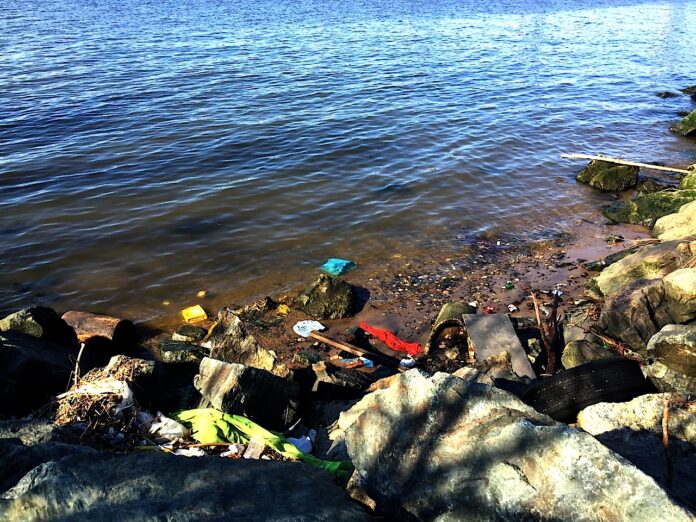After decades of neglect, New Jersey’s notoriously polluted Passaic River is finally targeted for a $1.4 billion cleanup – one of the most expensive efforts in the federal Superfund program’s 36-year history.
The Passaic stretches for 90 miles, starting its journey from an unnamed pond in Mendham and ending up in the Newark Bay. The river was once a mecca for industrialization and hydropower: Alexander Hamilton harnessed its power in 1778 at the Great Falls in Paterson to push forward the development of New Jersey’s industrial society.
Over 200 years of urbanization and industrialization around the lower portion of the Passaic has led to its degradation and contamination. The Passaic is considered one of the most polluted rivers in the nation, where fish that swim through the lower portion are considered contaminated and cancerous.
Some efforts have been made to clean up the river in the past: in 2012, the EPA completed the removal of 40,000 cubic yards of the most highly contaminated sediment in the river, adjacent to the former Diamond Alkali facility in Newark, said EPA public information officer Elias Rodriguez. From 2013 to 2014, the EPA oversaw the removal of another 16,000 cubic yards of contaminated sediment near Lyndhurst.
One of the most toxic man-made chemicals – dioxin – is found in high concentrations in this area of the Passaic. According to the EPA, most of this dioxin was generated by the Diamond Alkali facility before it was shut down decades ago.
Between the 1950s and 1970s, Diamond Alkali produced around 700,000 gallons of Agent Orange, an herbicide and defoliant used by the U.S. military during the Vietnam War. The plant was infamously known for dumping bad batches into the river, where contaminated sediments are still found in high quantities today.

How Bad Is It?
In author Mary Bruno’s “An American River: From paradise to superfund, afloat on New Jersey’s Passaic,” Robert Chant, a professor in the Department of Marine and Coastal Sciences at Rutgers-New Brunswick, said that when he shows his students the power of dioxin’s toxicity, he holds up a vial of four grams of sediment, falsely claiming that it is from the Passaic River.
Four grams of sediment, when actually containing dioxin, is enough to contaminate a lifetime’s supply of drinking water, according to Chant.
To put the pollution into perspective, there are 9.7 million cubic yards of tainted sediment, from dioxin to other waste products, currently in the river – the size of a pile of 9.7 million dishwashers.
Besides the Diamond Alkali plant, the EPA has identified more than 120 parties who may bear legal responsibility for the contamination.
EPA to Oversee Cleanup
Chant, who has conducted research on Passaic River sediment transport processes, said there have been some small cleanups in areas involving contaminated sediment, and at a hot spot near Diamond Shamrock – but that the “big dig” has yet to happen.
While it is apparent that the major source of dioxin to New York Harbor is the Passaic, the highest contaminant levels are a couple meters below the surface, he added.
“A project is going to cost several billion dollars, and there’s reasons to ponder that,” Chant said, “although it’s clear that the dioxins at the surface [of the river] are contaminated, and above the level of safe consumption of fish.”
There are over 100 contaminants in the river sediments, said Meiyin Wu, director of the Passaic River Institute at Montclair State University.
“The basin is home to more than two million residents,” Wu said. “So yes, it is important for people to know what is in the water.”
The EPA has a central role in seeing that the cleanup is performed, Rodriguez said.
“Now that the cleanup decision has been made, the EPA will negotiate with parties legally responsible for the contamination, to seek their performance of or payment for the work,” he added. “Whether negotiations are successful, or other enforcement actions are needed, the result will likely be an agreement or order that will address how the work is performed.”
The EPA will oversee the work, with the support of New Jersey, Rodriguez said. The organization also has the option to perform some of the work and recover the costs from the responsible parties.

Just Another Dead Body
Montclair-based writer Matt Kent, who writes under the pseudonym Wheeler Antabanez, has been following the Passaic for a decade. His “Nightshade on the Passaic” appeared in Weird New Jersey magazine, and he’s at work on a book and movie about his explorations.
Antabanez said he had come across many strange artifacts, from a 35-gallon steel barrel to police officials pulling up a dead body. He contacted a local news organization about pictures he had taken of this latter scene — but the organization barely covered the story.
“It turns out that they never really did a story on it; it was just another body in the Passaic,” he recalled. “It wasn’t really big news, but to me that was the most interesting part of it all — that there could be a dead body found in a river, and no one really cares about it, news-wise.”
Antabanez said he believes the river has been deeply stigmatized for its pollution – but admits that it lives up to its stigma.
“It is so polluted, it’s amazing sometimes,” he said. “It depends on the tide – sometimes you’ll go out there, especially on the lower Passaic, and there won’t be any garbage whatsoever. Then you go out the next day, and it’s like an obstacle course.”
Residents, Not Government Officials or Polluters, Live with Toxic Legacy
Those who live near the Passaic can attest to the stress the river causes.
April Lax, 22, has lived in the flood sections of Lincoln Park all her life.
“When we flood, it’s not just water that gets in the house,” Lax said. “It’s any fluids that have drained into the ground, or that have been dumped into the river, including oils, gases, and many other toxins that are not suitable for living situations, plus all the litter that is just tossed carelessly out.”
Since oil and water do not mix, oil is visible in floodwaters, Lax added, and lingers after the waters recede.
“Some things are permanently destroyed, and other have to be vigorously cleaned to get the stains and smells out,” she said.
Jerry Saulti, 21, of Chatham, said he spent a lot of time in the Passaic during his childhood, despite his mother warning him about damaging activity around the river. He’d come across shopping carts and broken beer bottles while scavenging nearby.
During high school, Saluti had the opportunity to collect data on the river, and agreed that, pollution notwithstanding, the area is a great teaching resource for science teachers.
The river is cleaner now than in the 1970s and 1980s, Wu said, though it’s still in poor condition.
Concentrations of contaminants have declined slightly over the past 20 years, according to an EPA fact sheet. Once the legal processes for the cleanup conclude, the plan for eradication will be outlined in a legally binding document.
The EPA expects the design alone to take three to four years to complete. The subsequent dredging, dewatering and disposal of dredged materials, and related construction, could take an additional six years.
This story received an honorable mention in the 2016 New Jersey Student Environmental Reporting Contest, part of the Geraldine R. Dodge Foundation-funded collaborative reporting project Dirty Little Secrets: New Jersey’s Toxic Legacy.


